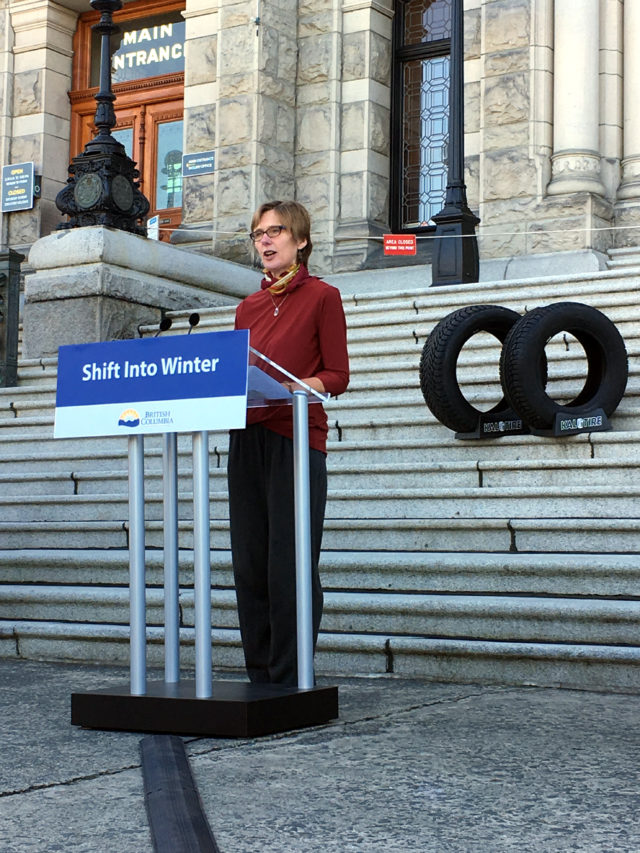
by Sophia Romanchuk ~ West Shore Voice News
October 11, 2018 ~ VICTORIA. Minister of Transportation and Infrastructure (MOTI) Claire Trevena and members of the Winter Driving Safety Alliance gathered on the steps of the legislature Wednesday afternoon to share an important message – winter driving safety is not something to be taken lightly.
The annual ‘Shift into Winter’ campaign event is being taken very seriously by MOTI this year after significantly above-average snowfall last year caused very difficult driving conditions and resulted in many accidents.
The number of fatal crashes caused by driving too fast for conditions doubles in December (on average, each year in BC), compared to October. In 2017 there were 246 crashes in December compared to 123 in October). The winter months of November, December and January are a particularly dangerous time for people who drive for work, with nearly 28% of all work-related crashes resulting in injury and time-loss claims occurring during these months. Six crashes a day on average were reported to WorkSafe BC in November alone last year.
“Highway safety is a shared responsibility,” said Minister Trevena, stressing the importance of checking road conditions, knowing your routes, and being prepared for sudden changes in driving conditions. Drivers in the lower mainland and Vancouver Island often aren’t as prepared as drivers in the interior and northern BC, but winter tire regulations apply to everyone on the road. This is especially important for any drivers planning on travelling this winter, as “people travelling this winter are expected to know before you go,” says Trevena.
The shift to snow tire regulations on BC roads began October 1, and this year is are being extended an extra month on certain routes, to April 30. This new measure is to account for additional early spring snowfall on select mountain passes and rural highways. This does not apply to the Malahat (on Highway 1, on south Vancouver Island), on which the snow-tire regulation period will end on March 31, as usual.
Drivers are expected to know what routes snow tires are required on, and Minister Trevena says the routes will be clearly marked. Here’s where winter tires or chains are required: https://bit.ly/2Qim9ZL
Police will be targeting unsafe drivers this winter, says Victoria Police Dept Deputy Chief Jason Laidman, on behalf of the Winter Driving Safety Alliance. The goal is safety, first and foremost – to “ensure everyone gets to where they’re going, home, safely, at the end of the day,” says Laidman. The WorkSafe BC rep added “these accidents don’t just happen, they are caused.”
Why are good tires important? “They can literally save your life,” says Minister Trevena. Snow tires shorten stopping distance significantly in less than ideal driving conditions. Ben Springsteen from Kal Tire, a member of the Safety Alliance, explained the differences between types of tires at the event. He also said that drivers are advised to watch out for changing conditions below 7 degrees, as this is when regular all-season tires begin to lose elasticity, and to be aware that their tires might react differently on the road.
 The three types of tires drivers need to know about are all season, all weather, and winter tires. All are designed to work well in wet and slush conditions, but all weather and winter tires have larger treads and studs for extra traction.
The three types of tires drivers need to know about are all season, all weather, and winter tires. All are designed to work well in wet and slush conditions, but all weather and winter tires have larger treads and studs for extra traction.
Starting October 1, drivers are required to equip their vehicles with winter tires (mountain/snowflake or M+S) with a minimum 3.5 millimetre tread depth, and commercial vehicles were required to carry chains. Tires marked with a mountain/snowflake symbol on the sidewall offer the best traction on snow and ice and in cold weather.
Tips for safe winter driving:
* Plan the route ahead of time. Check current highway and weather conditions on DriveBC.ca and @DriveBC on Twitter. Delay travel if conditions are unsafe.
* Invest in winter driving training. Learn how to brake safely, how to get out of a skid and how cars handle in winter weather.
* Slow down. The posted speed limit is the maximum speed under ideal driving conditions, so when inclement weather hits, slow down and drive with extra care.
* Be prepared. Bring suitable clothing, emergency supplies and a fully charged cellphone in case of travel delays or a motor vehicle incident.
For more winter driving safety tips, and to find out more about the Winter Driving Safety Alliance and the Shift into Winter campaign: http://www.shiftintowinter.ca


